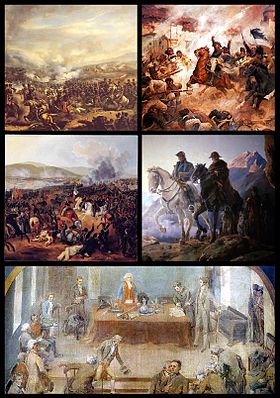Chilean Independence
| Chilean War of Independence | |||||||
|---|---|---|---|---|---|---|---|
| Part of the Spanish American wars of independence | |||||||
 Clockwise from top left: Battle of El Roble, Battle of Rancagua, Battle of Maipú, Crossing of the Andes, First Government Junta |
|||||||
|
|||||||
| Belligerents | |||||||
| Mapuche allies | |||||||
| Commanders and leaders | |||||||
Chilean victory
The Chilean War of Independence was a war between pro-independence Chilean criollos seeking political and economic independence from Spain and royalist criollos supporting continued allegiance to the Captaincy General of Chile and membership of the Spanish Empire.
Traditionally, the beginning of the war is dated as September 18, 1810. Depending on what terms are used to define its end, it lasted until 1821, when royalist forces were defeated by José de San Martín; or until 1826, when the last Spanish troops surrendered and the Chiloé Archipelago was incorporated to the Chilean republic. A declaration of independence was officially issued by Chile on February 12, 1818 and formally recognized by Spain in 1844, when full diplomatic relations were established.
The Chilean War of Independence was part of the more aroused Spanish American wars of independence. Independence did not have unanimous support among Chileans, who were divided between independentists and royalists. What started as a political movement among elites against the colonial power, ended as a full-fledged civil war. Traditionally, the process is divided into three stages: the Patria Vieja, 1810–1814; the Reconquista, 1814–1817; and the Patria Nueva, 1817–1823.
...
Wikipedia
